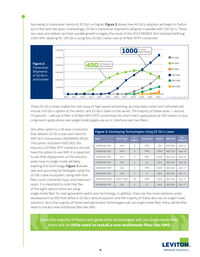Data centers are rapidly evolving to address rising volumes of network traffic. Faced with increasing bandwidth demand and the need to adapt and scale quickly, many organizations with small or medium data centers have moved to cloud service providers or have outsourced to colocation facilities. In addition, many large enterprise data centers with traditional three-tier architectures are changing to “flatter” leaf-spine architectures, creating lower latency and more scalable designs.
As these data centers adapt, one trend has become clear: while both cloud data centers and large enterprise data centers invest heavily in next-generation network infrastructure, they deploy different types of optics and cabling systems.
For the purpose of this whitepaper, we define the size of a data center by the number of servers or switches it hosts. A cloud data center generally has upwards of 100,000 or more servers, while a large enterprise data center will has around 10,000 or more servers. Small-to-medium data centers may have 500 servers or less.

